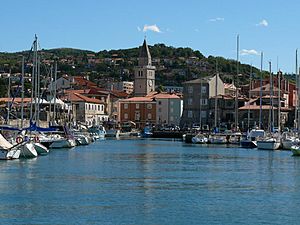Italian irredentism in Istria facts for kids
Italian irredentism in Istria was the political movement dedicated to the unification of Istria to Italy.
Characteristics
When Napoleon defeated Venice in 1797 he found that Istria was populated by Italians on the coast and in the main cities, but the interior was populated mainly by Croats and Slovenians.
This dual ethnicity in the same peninsula created a situation of antagonism (hostility) between Slavs and Italians for the supremacy of Istria, which started the first nationalisms after Napoleon's fall.
Since 1815 Istria was a part of the Austrian monarchy, and Croats/Slovenians and Italians engaged in a nationalistic fight with each other.
As a consequence Istria has been the theater of an ethnic struggle between them, with bloody nationalistic wars, during the XIX and XX centuries. The Italian irredentism was actively followed by many Italians in Istria (called Istrian Italians), like the Italian hero Nazario Sauro of Capodistria (actual Koper).
Indeed, between 1918 and 1947 Istria was part of the Kingdom of Italy, but after WWII was part of Yugoslavia. Now the Istrian Italians are reduced to a small minority, who has survived the Istrian exodus and the Foibe massacres during and after WWII.
Furthermore, after the war was created the Free Territory of Trieste in north-western Istria: in the years following the division of the territory between Italy and Yugoslavia, up to 40,000 Istrian Italians chose to leave the Yugoslav "B zone" and move to the "A zone" or Italy for various reasons - some were intimidated into leaving and some simply preferred not to live in Tito's Yugoslavia.
Since the end of WWII the irredentism has totally disappeared in Istria, even because of the Istrian exodus.
Actually Istria is populated mainly by Slavs, but nearly 50,000 Italians still live there (divided between the areas of Istria belonging to Croatia, Slovenia and Italy).
Capodistria and Muggia
Capodistria (actual Koper) and Muggia were the centers of the irredentism in Istria. In these cities there was the main Comitato istriano (Istrian Committee for Union to Italy), the meeting place of the most famous istrian irredentists like Carlo Combi e Antonio Madonizza. From there sailed, in 1848, many Istrian Italians to fight for Venice against the Austrians with the Legione Istriano-dalmata.
After 1866 - when Venice and the Veneto region were united to Italy - in all Istria there was full support for the irredentism. The Italian hero Nazario Sauro was born in Capodistria.
Actually only Muggia remains Italian, as part of the Province of Trieste.
- Večerina, Duško. Talijanski Iredentizam ( Italian Irredentism ) ISBN: 953-98456-0-2, Zagreb, 2001
- Vignoli, Giulio. I territori italofoni non appartenenti alla Repubblica Italiana. Giuffrè Editoriale. Milano, 1995.
- Vivante, Angelo. Irredentismo adriatico. Venezia, 1984
Related pages
- Istrian Italians
- Italian irredentism
- Italian irredentism in Dalmatia
Images for kids
-
Like those of Istria, most of the inhabitants of Fiume cheered the union to Italy after WWI
See also
 In Spanish: Irredentismo italiano en Istria para niños
In Spanish: Irredentismo italiano en Istria para niños



